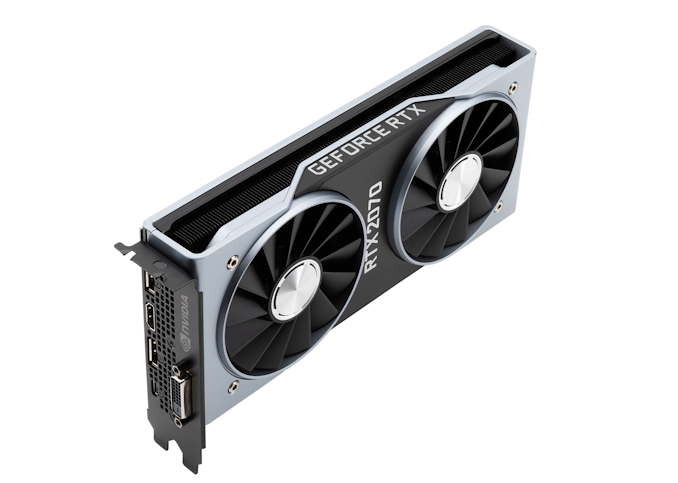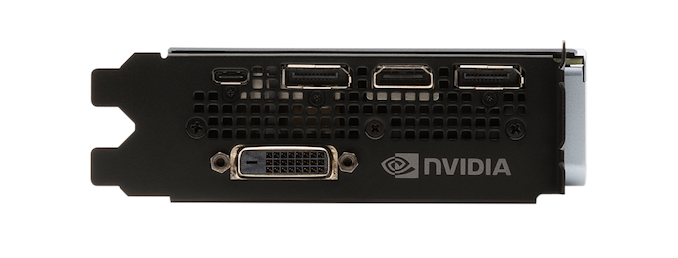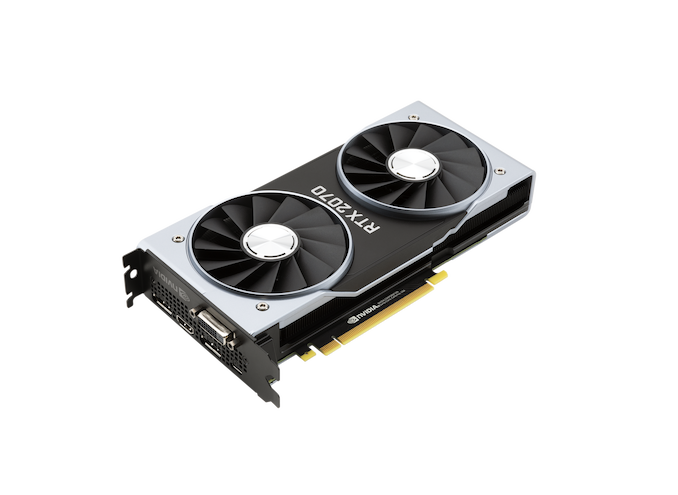The NVIDIA GeForce RTX 2070 Founders Edition Review: Mid-Range Turing, High-End Price
by Nate Oh on October 16, 2018 9:00 AM ESTMeet The GeForce RTX 2070 Founders Edition Card
Touching quickly on the card itself, there's little we haven't already seen with the RTX 2080 Ti and 2080 Founders Editions. The biggest change is, of course, a new open air cooler design. Along with the Founders Edition specification changes of +10W TDP and +90 MHz boost clockspeed, the cards might be considered 'reference' in that they remain a first-party video card sold direct by NVIDIA, but strictly-speaking they are not because they no longer carry reference specifications.
Wrapped in the flattened industrial design introduced by the other RTX cards, the RTX 2070 Founders Edition looks essentially the same, save a few exceptions. The single 8-pin power connector is at the front of the card, while the NVLink SLI connectors are absent as the RTX 2070 does not support SLI. Internally, the dual 13-blade fans accompany a vapor chamber, while a 6-phase system provides the power for the 185W TDP RTX 2070 Founders Edition.
So while the single 8-pin configuration, suitable for up to 225W total draw, has remained the same from the GTX 1070, the TDP has not. The RTX 2070 Founders Edition brings 185W, with reference specification at 175W, compared to the 150W GTX 1070 and 145W GTX 970, following the trend of the 2080 Ti and 2080 pushing up the watts.
As for I/O, there is one difference between the 2070 and its older siblings. The RTX 2070 Founders Edition drops the isolated DisplayPort for a DVI port, matching the GTX 1070's outputs. This is in addition to DisplayPort 1.4 and DSC support, the latter of which is part of the DP1.4 spec, as well as the VR-centric USB-C VirtualLink port, which also carries an associated 30W not included in the overall TDP. While the past few years have seen DVI excised from the top-end cards, it's more of a matter of practicality for mid-range cards (inasmuch as $500 is a midrange price) that are often paired with budget DVI monitors, particularly as a drop-in upgrade for an aging video card.
As mentioned in the RTX 2080 Ti and 2080 launch article, something to note is the potential impact on OEM sales with this reference design change. The RTX 2070 also arrives as an open air design and so can no longer guarantee self-cooling independent of chassis airflow. In addition to the price and lower volume nature of these GPU parts, these aspects make the RTX reference cards less suitable for large OEMs.














121 Comments
View All Comments
TheinsanegamerN - Tuesday, October 16, 2018 - link
Because the 2070 is a 1070 replacement? Why do you people get hung up on "WELL IT COST A BUNCH SO ITS A HIGH TIER CARD"No, it isnt, its a mid tier card with a high tier pricetag. It doesnt make sense to compare the 2070 to a 1080ti because of the pricetag, anymore then comparing a vega 64 to a 1070 because they both cost $400 at some point.
ioni - Tuesday, October 16, 2018 - link
2070's die size is closer to the 1080 ti than it is to the 1080. It should be, at minimum, being compared to a 1080.Nioktefe - Tuesday, October 16, 2018 - link
Exactly, it could be called RTX 2050 and still use the same chip, don't compare marketing with die specifications, RTX chips are huge, and they are priced accordingly to that, we will never see 2080Ti come close to 1080ti pricesPeachNCream - Tuesday, October 16, 2018 - link
^^ So much of this right here! Name it what whatever, but the retail price is ultimately what dictates what it must compete with from prior generations or from the nearest competitor. As far as pricing is concerned, the RTX 2070 must contend with the GTX 1080Ti and 1080 when a present day buyer is looking at options in that price range.tamalero - Wednesday, October 17, 2018 - link
die size is irrelevant, price points is what is important in price brackets.. if the 2070 is on 1080gtx prices for a tiny improvement, its not worth it..Vayra - Monday, October 22, 2018 - link
Die size is not irrelevant. Cause & Effect: larger die = lower yield per wafer = higher price.CheapSushi - Thursday, October 18, 2018 - link
Do you make your choice based on die size OR price?dguy6789 - Tuesday, October 16, 2018 - link
What an absolutely ridiculous statement. People don't cross shop products that have radically different pricing- they pick a budget and look for what is best in that price segment. Hmmm I'm torn between a Kia and a BMW. Yeah right.evilspoons - Wednesday, October 17, 2018 - link
That's reasonable, the Kia Stinger is a pretty decent RWD/AWD luxury sedan. For like $45k CAD you get roughly what you'd have to pay $65k CAD to get in a BMW, so a $45k BMW by contrast is a much less interesting vehicle. (Although personally, I'd go with the Genesis G70 instead of the Kia, you can get it with a 6-speed manual.)khanikun - Friday, October 19, 2018 - link
Car analogies do and don't work here. Some might start with size, while other start with price. Some will start with looks, some will start with power, some will start with drivetrain, etc. Some will cross shop products that have different prices, some won't.Some might be torn between a Kia and a BMW, if both made rwd sports cars that compete against each other, even with a price tag difference. Look at all the comparisons between something like a Subaru WRX STI vs a BMW M3, even though the M3 is easily $20k over the STI.
The only time I see someone set a budget first, is those looking at the used car market. Not the looking at the new car market.